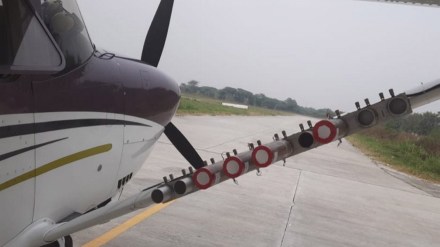The Delhi government carried out two cloud seeding trials on Tuesday to try and bring artificial rain to the city in order to fight rising pollution levels. The tests were carried out using a Cessna plane fitted with salt-based and silver iodide flares, meant to encourage rainfall. But by Tuesday evening, both flights from Kanpur and Meerut had failed to produce any rainfall.
The attempts were “not completely successful” because the flares released from the aircraft didn’t result in any rain. “We did two sorties, one in the afternoon and one slightly later in the evening. A total of, I believe, 14 flares were fired. These were fired and the aircraft returned to Meerut. There hasn’t been any rains so far. So, in that sense, it is not completely successful,” Manindra Agrawal, Director of IIT Kanpur, told NDTV.
Why the trials didn’t work
A report by the Delhi government said the moisture level in the atmosphere was too low for successful cloud seeding. The IMD had predicted only about 10-15% moisture, which isn’t ideal for this kind of operation.
Agrawal also mentioned that although there were clouds, they didn’t have enough moisture to create rain. “The clouds that are present today do not have very high moisture content. I was told that it was only 15-20%. So, the possibility of causing rain with such low moisture content is not very high,” he told the news outlet.
He added that a third round of trials is expected to be held on Wednesday. “We hope that at least this trial has given more confidence to our team that we can continue conducting these trials. We will again try tomorrow,” he said.
Areas covered in the operation
Delhi Minister Manjinder Singh Sirsa confirmed that two trials were done on Tuesday, mainly over the outer parts of the city. “Two cloud seeding trials were conducted in Delhi today, this was the third overall. The first took off from Kanpur this morning and the second from Meerut. Today’s trial covered areas in outer Delhi. So far, this has been a historic trial,” he said.
Adding to it he mentioned that the planes covered areas like Khekra, Burari, North Karol Bagh and Mayur Vihar. During the process, eight flares weighing between 2 and 2.5 kilograms each were used.
How cloud seeding affected pollution
Even though the attempts didn’t lead to rain, the Delhi government’s report said the cloud seeding helped reduce pollution levels in the targeted areas. It mentioned that two small precipitation events were recorded – one in Noida (0.1 mm of rain) and another in Greater Noida (0.2 mm).
The report noted that levels of particulate matter, PM2.5 and PM10, dropped after the operation.
“The PM2.5 was 221, 230 and 229 reported from Mayur Vihar, Karol Bagh and Burari respectively before cloud seeding, which reduced to 207, 206 and 203 respectively after the first seeding. Similarly, PM10 was 207, 206 and 209, which got reduced to 177, 163 and 177 at Mayur Vihar, Karol Bagh and Burari respectively,” the report said, according to PTI.
The first test began when the Cessna aircraft took off from the IIT Kanpur airstrip at 12.13 pm, covering Khekra, Burari, North Karol Bagh, Mayur Vihar, Sadakpur, and Bhojpur. The second flight took off from the Meerut airstrip, carrying four kilograms of seeding material, and covered Khekra, Burari, Mayur Vihar, Pavi Sadakpur, Noida, Bhojpur, Modinagar and Meerut.
